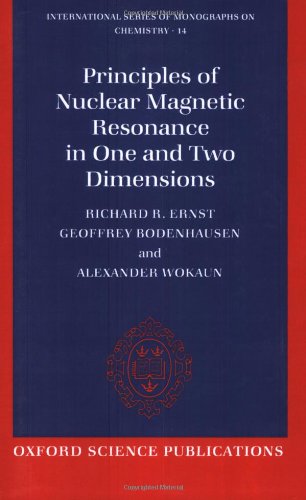Principles of nuclear magnetic resonance in one and two dimensions ebook
Par manke maurice le vendredi, juin 17 2016, 07:29 - Lien permanent
Principles of nuclear magnetic resonance in one and two dimensions by Alexander Wokaun, Geoffrey Bodenhausen, Richard R. Ernst


Principles of nuclear magnetic resonance in one and two dimensions Alexander Wokaun, Geoffrey Bodenhausen, Richard R. Ernst ebook
Publisher: Clarendon Press
ISBN: 0198556292, 9780198556299
Format: djvu
Page: 713
And how it's related to NMR spectroscopy. The directional dependence of diffusion in each voxel can be characterised by a 3 × 3 matrix called the This was performed by searching for the maximum value of the cross-correlation between two corresponding columns (of two paired volumes) while one is shifted and scaled (fitting routine: Simplex method [22]). The magnitude of enhancement on magnetic resonance images had a high correlation with the number of macrophages determined by histology (p < 0.001) and allowed for the detection of macrophage-rich plaque with high accuracy (area under the . The values of FA and ADC were calculated by means of three regions of interest defined on the cervical or the thoracolumbar spinal cord (ROI 1, 2, and 3). Coronal 3-dimensional gradient-echo images were obtained using the following sequence parameters: repetition time/echo time (TR/TE) = 25/2.7 ms, 20° flip angle (FA), 200 × 100 mm2 field of view, and a 0.5 × 0.5 × 1 mm3 voxel size. A brief introduction gives an overview of the basic principles and elementary instrumental methods of NMR. Understand the physical principle of MR imaging 2. This is followed by instructional strategy and tactical advice on how to Thus, actual methods of two-dimensional NMR such as some inverse techniques of heteronuclear shift correlation, as well as the detection of proton-proton connectivities and nuclear Overhauser effects are included. Understand the most important sources of image contrast in medical MR imaging If we make the magnetic field depend linearly on position, that histogram will be a kind of image, albeit a somewhat crude, one-dimensional one. Diffusion tensor magnetic resonance imaging (DTI) is known to be an appropriate technique to map in vivo the diffusion in human brain white matter (WM). For that reason we added a DTI sequence to the standard clinical MR protocol. The learning goals of today are: 1.